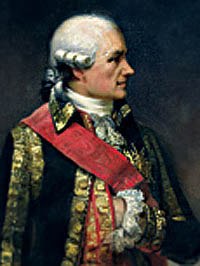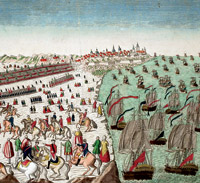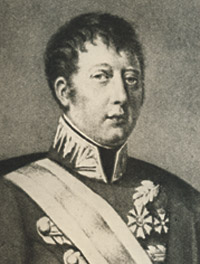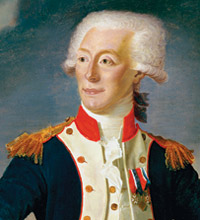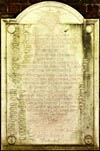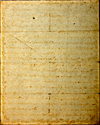Company for Christmas
by Christopher Geist
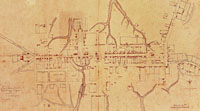
A detailed view of Williamsburg at the time, the Frenchman’s Map was drawn during the French quartering there in 1781–82.
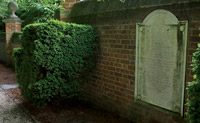
On a wall behind the Governor’s Palace, a plaque honors the 150 American soldiers who lie in unmarked graves on the grounds.
Williamsburg had guests for Christmas in 1781. Regiments of them, hundreds of French soldiers at winter quarters in and around the city. There was, after years of war and worry, something extraordinary to celebrate that Yuletide. Commanded by Jean-Baptiste Donatien de Vimeur, comte de Rochambeau, the troops, who would linger through June, had helped the Americans and General George Washington beat General Charles Lord Cornwallis and the British two months before at Yorktown.
Reared in the manners of more worldly Europe, and officered by men of pretensions to social as well as military rank, the soldiers brought with them the prospects of more entertainment and gaiety than had been seen in the city since Virginia’s government removed to Richmond in April 1780. When Williamsburg was no more a center of power, the population of Virginia’s second capital—Jamestown was the first—began to dwindle, its commerce to diminish, and the sphere of opportunities for social and celebratory activities to lessen. Public buildings were put to utilitarian uses, and the city, once the scene of momentous political events, was on its way to becoming just another country village. Only memories of its former political glory and consequence remained. But there were yet people prepared to have a good time. And more than in years.
Armies had occupied Williamsburg more or less continuously since June 25, 1781, when Cornwallis’s troops marched in. The redcoats left July 4, but American troops led by the marquis de Lafayette, General Anthony Wayne, and Baron Friedrich von Steuben occupied the city as they maneuvered for control of Virginia’s Lower Peninsula. A circuitous campaign took Cornwallis, by way of Jamestown, south across the James to Portsmouth on July 14, and north, August 1, to Yorktown and the Chesapeake. Trapped there, by land and sea, Cornwallis capitulated October 17.
The victors marched British and Hessian prisoners west under escort to prison camps in Winchester and Frederick, and Cornwallis and paroled British officers sailed for New York. Washington went north with most of the American regulars, and others under Wayne’s command moved south. The majority of the militia went home. The French and the most seriously wounded Americans remained behind on the Peninsula. Rochambeau and his troops began to establish winter quarters at Jamestown, Gloucester, West Point, Back River, Halfway House, and Hampton. But the most important French winter billet was Williamsburg.
Elite French units, including seven companies of the Royal Deux-Ponts and the Bourbonnais Regiments, joined Rochambeau and his staff there. The commander assured the citizens the troops would cause as little inconvenience and expense as possible, and settled into the Wythe House.
Williamsburg welcomed the Frenchmen warmly. Their army hospitalized its wounded at the College of William and Mary’s main building, and the Americans theirs at the former Governor’s Palace, or the Government House, as the French also called it. Troops billeted throughout town and set up camps nearby. Many of the visitors wrote of their experiences in diaries and letters. Often brief and sometimes vague, the documents provide glimpses of a town redeemed from the doldrums.
A Rochambeau aide wrote that Williamsburg
...consists of two parallel streets, and two or three which cross them. These streets are perfectly straight, but they are not paved. There are three buildings quite worthy of notice which belong to a very large College . . . the Government House, which is in a very bad condition . . . the Capitol, where the Courts were held, is also a very fine edifice. ...The town is thinly peopled. The war has ruined a great many persons, some of whom have even abandoned the country, which is devastated.
Baron Ludwig von Closen, a captain of the Deux-Ponts Regiment, said many of Williamsburg’s “inhabitants have been ruined by the frequent visits from enemies and friends.” He described the college and the Capitol, and said the Governor’s Palace “is in very bad condition, but the great hall and other rooms, although damaged, still show that Lord Dunmore must have lived there in great style.” Von Closen saw “very few horses, since all the wealthy citizens had sent theirs into the interior” to keep them from Cornwallis. He said, “The war has caused much suffering.”
Another visitor said the homes were “very mean.” Some mentioned the unpaved streets, one calling them “very inconvenient in summer and in winter.” The college was generally bereft of students and professors. “The tumult of war has broken up the institution,” an American visitor wrote.
French commentators appreciated Virginia hospitality. Von Closen said:
One could not be more hospitable than are the inhabitants of Williamsburg to all the army officers; they receive them very cordially in their homes and do all in their power to provide entertainment for them (according to the custom of the country, however).
The town treated the troops to a social season that ran at least from late November through late spring. There were hunts, balls, banquets, plays, all manner of gaming, and cockfights, activities familiar and favored by most Virginians, especially those of the upper classes. Officers and enlisted men went fishing and crabbing. Horse races were run. Billiards and backgammon were enjoyed in the taverns.
French officers were guests at Williamsburg dinner tables. One French officer wrote, “The people here have a special way of curing” hams “that consists of salting and smoking them almost as we do in France; however, ours cannot touch theirs for flavor and quality.”
An artillery officer stationed near West Point, comte de Clermont-Crèvecoeur, wrote, “These people are very hospitable and receive you in a most cordial manner.” The women, he said, “have the advantage of being much gayer by nature than the northern women, though not so pretty. They love pleasure and are passionately fond of dancing.” Von Closen said, “In this city, the fair sex, although they are not the prettiest I have seen, form a very agreeable and, in general, very well-bred society.”
Congress proclaimed December 15, 1781, a day of celebration in honor of the Yorktown victory, and the Christmas season’s gaiety began early. Rochambeau had a Te Deum mass sung in Williamsburg, just as his king had done in Paris. After the solemnity, the French troops paraded through town, offered three musket volleys, and concluded with cannon salutes.
The gala concluded with a banquet and dance, Rochambeau the host. According to von Closen, everyone was “very much pleased with it.” Virginia minuets and French quadrilles were danced, and an observer wrote that Williamsburg’s ladies were “without exception charmed” by the French dancing and manners.
There were hard, if unintended, consequences of the occupation. At the college hospital for French casualties, there was insanitation:
For ease and convenience, they had contrived a common necessary for their whole hospital, the college, a large building, three stories high, by erecting a half hexagon, of common boards, reaching from the roof down to a pit in the earth. From this perpendicular conduit doors opened upon each floor of the hospital; and all manner of filth and excrementitious matters were dropped and thrown down this common sewer. . . . This sink of nastiness perfumed the whole house very sensibly and, without doubt, vitiated all the air within the wards.
Fire damaged the college President’s House on November 23. Scientific apparatus and much of the president’s library were lost. The officers housed in the building were removed safely. The main structure, now known as the Wren Building, was unharmed. Rochambeau arranged for the king of France to reimburse the college for its loss. The night of December 22, the Governor’s Palace, hospital for American wounded, burned. A few days later, the Royal Gazette of Charleston, South Carolina, reported:
Last Saturday night about eleven o’clock the palace in the City of Williamsburg, which is supposed to have been set on fire by some malicious person, was in three hours burnt to the ground. This elegant building has been for sometime past a continental hospital, and upwards of one hundred sick and wounded soldiers were in it when the fire was discovered, but by the timely exertions of a few people, only one perished in the flames.
Rochambeau wrote to Washington: “We saved all the sick, most of the effects, and prevented the fire from spreading to the neighboring houses, notably my” headquarters, “which is the first of those occupied by your Excellency and which was covered all night with a rain of fire. We have gathered all our sick in the Capitol and this day I have given them all the help in my power.”
The Capitol, like other public buildings, including some churches, became a military hospital. Left behind on the Palace grounds were the graves of more than 150 American soldiers and at least two women. The unmarked graves are preserved and memorialized by a plaque on a garden wall overlooking the site. News that French forces had recaptured a small Dutch West Indies island from the British reached Virginia soon after Christmas. Jean-Baptise-Antoine de Verger, sublieutenant of the Royal Deux-Ponts, wrote, “On 28 December we lighted bonfires to celebrate the capture of St. Eustasius.”
The celebrations and social season extended beyond Christmas and Twelfth Night, but the festivities amused not everyone. Peter Colt, a merchant from New England, wrote a letter home to his wife on March 14, 1782, that read in part:
This town was formerly the Capital of Virginia—has many fine Buildings & the people were gay. But its glory departed. Some of the best Buildings have been burnt by accident—some by Design—many were ruined by the British—some by the present occupiers—were it not for the French officers it would be a dead calm, at present all is life & gaiety. . . . Every article of living . . . is dear in this Country, & the Difficulty is increased by the universal spirit of gambling, Horse racing & other expressive Diversions—rest assured I shall feel mighty happy at leaving this part of the Country.
Historian John Selby writes, “When the French at last announced their departure the following June, their hosts expressed genuine regret, not only because of the defense the French afforded, but because the visitors had been model guests whose discipline and deportment the Virginians universally lauded.” As early as January 15, the citizenry praised the discipline and good order of the French troops and noted their “scrupulous attention to never violate the privileges and immunities of the free citizens.” In an address to the mayor, aldermen, and councilmen of the City of Williamsburg, June 23, 1782, Rochambeau said:
I could not, Gentlemen, but be pleased with the circumstances which have enabled me to form with you an intimate connection, a connection wholly independent of the Great Objects of the war, and of public affairs. During the time I have spent with you I have enjoyed those social qualities by which the inhabitants of this great and flourishing country are so eminently distinguished.
The French departed for Boston by July 4 and from there began the journey back to France. Williamsburg resumed its off-the-beaten-path existence and slipped into a peaceful life that lasted, more or less uninterrupted—one resident wrote of grass growing in the streets—until the Civil War, when Union forces took over the town after the Battle of Williamsburg. Somnolence set in again during the 1870s, to be foreshortened by an industrial boom fostered by a World War I munitions plant, and, in 1926, by the reconstruction of the city on its eighteenth-century heritage.
Much of the verisimilitude of the Restoration traces to what is taken to be a billeting plan drawn by a French officer in 1782 and now owned by the college. Known as The Frenchman’s Map, the document is a tangible and invaluable connection to Williamsburg’s eighteenth-century world which would not exist were it not for the French occupation.
Suggestions for further reading:
- Jane Carson, We Were There (Charlottesville, VA, 1965).
- Baron Ludwig von Closen, The Revolutionary Journal of Baron Ludwig von Closen (Chapel Hill, NC, 1958).
- Richard M. Ketchum, Victory at Yorktown (New York, 2004).
- John E. Selby, The Revolution in Virginia, 1775–1783 (Williamsburg, 1988).

